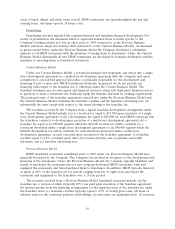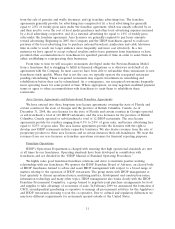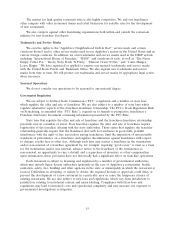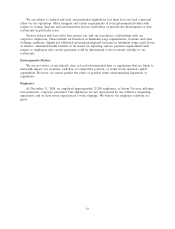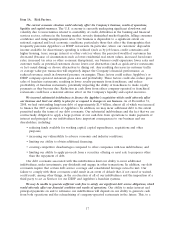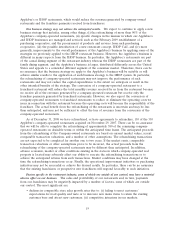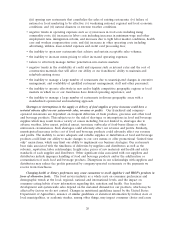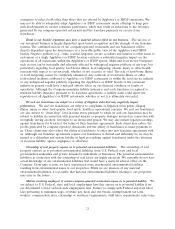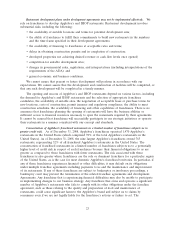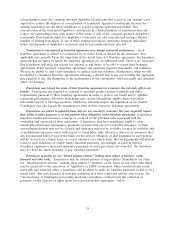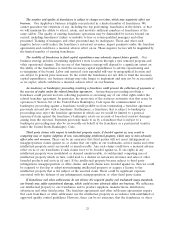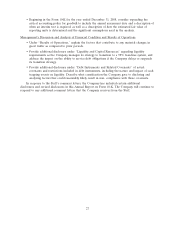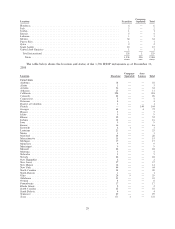IHOP 2008 Annual Report Download - page 33
Download and view the complete annual report
Please find page 33 of the 2008 IHOP annual report below. You can navigate through the pages in the report by either clicking on the pages listed below, or by using the keyword search tool below to find specific information within the annual report.Applebee’s or IHOP restaurants, which would reduce the revenues generated by company-owned
restaurants and the franchise payments received from franchisees.
Our business strategy may not achieve the anticipated results. We expect to continue to apply a new
business strategy that includes, among other things, (i) the refranchising of more than 90% of the
Applebee’s company-operated restaurants, (ii) specific changes in the manner in which our Applebee’s
and IHOP businesses are managed and serviced, such as the February 2009 establishment of a
purchasing cooperative, and the procurement of products and services from such purchasing
cooperative, (iii) the possible introduction of a new restaurant concept, IHOP Caf´
e, and (iv) more
generally, improvements to the overall performance of the Applebee’s business by applying some of the
strategies we previously applied to the IHOP restaurant business. However, the Applebee’s business is
different in many respects from the IHOP business. In particular, the Applebee’s restaurants are part
of the casual dining segment of the restaurant industry whereas the IHOP restaurants are part of the
family dining segment, and the Applebee’s business is larger, distributed differently across the United
States and appeals to a somewhat different segment of the consumer market. Therefore, there can be
no assurance that the business strategy we apply to the Applebee’s business will be suitable or will
achieve similar results to the application of such business strategy to the IHOP system. In particular,
the refranchising of company-operated restaurants may not improve the performance of such
restaurants and may not reduce the capital expenditures to the extent we anticipate or result in the
other intended benefits of the strategy. The conversion of a company-operated restaurant to a
franchised restaurant will reduce the total monthly revenue received by us from the restaurant because
we receive all of the revenues generated by a company-operated restaurant but receive only the
franchise payments generated by franchised restaurants. However, we also expect the conversion of
company-operated restaurants to franchised restaurants to reduce or eliminate the operating costs we
incur in connection with the restaurant because the operating costs will become the responsibility of the
franchisee. The actual benefit from the refranchising of the restaurants is uncertain and may be less
than anticipated, and may not be sufficient to offset the loss of revenues from the conversion of the
company-operated restaurants.
As of December 31, 2008 we have refranchised, or have agreements to refranchise, 110 of the 510
Applebee’s company-operated restaurants acquired on November 29, 2007. There can be no assurance
that we will be able to complete the refranchising of approximately 380 of the remaining company-
operated restaurants on desirable terms or within the anticipated time frame. The anticipated proceeds
from the refranchising of the Company-owned restaurants are based on current market values, recent
comparable transaction valuations, and a number of other assumptions. The refranchising transactions
are not expected to be completed for another one to two years. If the market rents, comparable
transaction valuations or other assumptions prove to be incorrect, the actual proceeds from the
refranchising of the company-operated restaurants may be different than anticipated. In addition,
adverse economic, market or other conditions existing in the states in which company-operated real
property is located may adversely affect our ability to execute the refranchising transactions or to
achieve the anticipated returns from such transactions. Market conditions may have changed at the
time the refranchising transactions occur. Finally, the operational improvement initiatives or purchasing
initiatives may not be successful or achieve the desired results. In particular, there can be no assurance
that the existing franchisees or prospective new franchisees will respond favorably to such initiatives.
Factors specific to the restaurant industry, some of which are outside of our control, may have a material
adverse affect on our business. The sales and profitability of our restaurants and, in turn, payments
from our franchisees may be negatively impacted by a number of factors, some of which are outside
our control. The most significant are:
• declines in comparable store sales growth rates due to: (i) failing to meet customers’
expectations for food quality and taste or to innovate new menu items to retain the existing
customer base and attract new customers; (ii) competitive intrusions in our markets;
19



